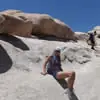Join our next Twitter chat with @WeddingWire, where we'll answer your questions about sweating for the wedding. Check in with @ACTIVE on Twitter with #ACTIVEchat at 2 p.m. CDT May 26.
When all the wedding planning and festivities have ended, get cozy with your new spouse around a campfire.
Don't stifle the newlywed flame by failing to properly plan. Relying on first-come, first-served campsites during your honeymoon will only translate to stress.
Use these tips to decide where you want to go, what you need to bring and how you'll stay busy during the day. Planning ahead makes your honeymoon the least hectic and most romantic camping vacation possible.
More: How to Plan a Romantic Camping Trip
Ask Yourselves: Will it be a Road Trip or Destination Trip?
Your first task is to determine whether you'll stay in one campground the entire time or make it a road trip, travelling from one spot to another each day. The beauty of doing a road trip is that you can see new places every day, while one destination will allow you to explore a variety of places within the same area.
If you're not sure, consider how much exploring can be done in the one area you want to visit. For example, places like the Grand Canyon and Yosemite National Park can't be explored in one day. These locations are better suited for a one-destination trip.
More: How to Organize Your Camping Kitchen
If you want to explore the east or west coast or visit a variety of parks that are clustered together, like many of those in the Southwest, make it a road trip. Decide how long you want to stay at each place. For example, one day here, two days there etc.
With each stop planned you can reserve campsites ahead of time, buy tickets for events or locations, and research nearby hikes and excursions.
Make a List—What Can You See and Do?
Make a list of the places you want to see and activities you want to do during your camping honeymoon. Take time to research; ask friends and family, check websites like Yelp and Trip Advisor, and use Google Maps to find lakes and forests. Plan back-up options in case something is suddenly closed, like a hiking trail, roadside attraction or other tourist spot.
Pack Only What You Need?
Leave expensive or unnecessary items at home. If you're spending long days away from the campsite, you don't want to leave valuables in your car. This also makes long car rides more comfortable and can help save on gas, especially if you leave large, heavy items at home.
If you're traveling from one destination to the next, only buy food for one or two destinations at a time. This alleviates the weight of a cooler full of ice (or water; the ice will inevitably melt on the drive) and means you'll have fresh food at each stop.



